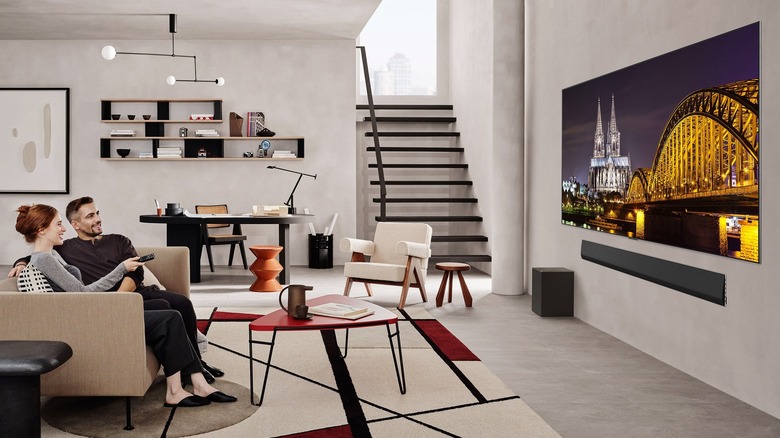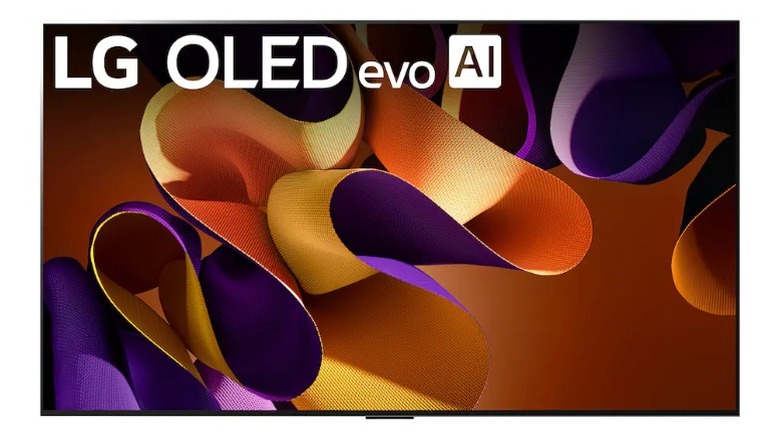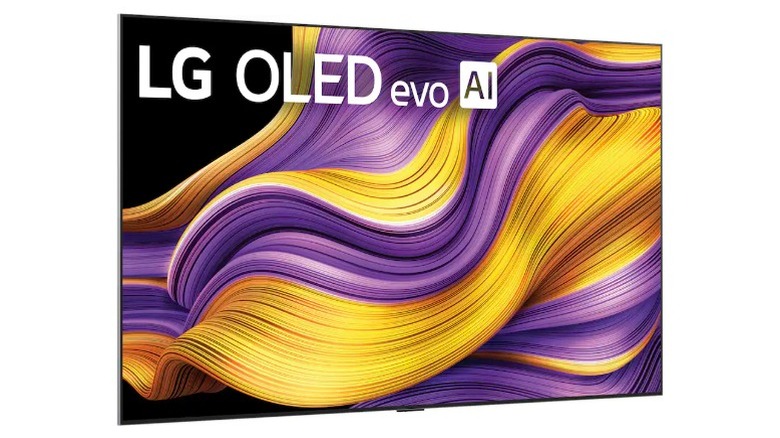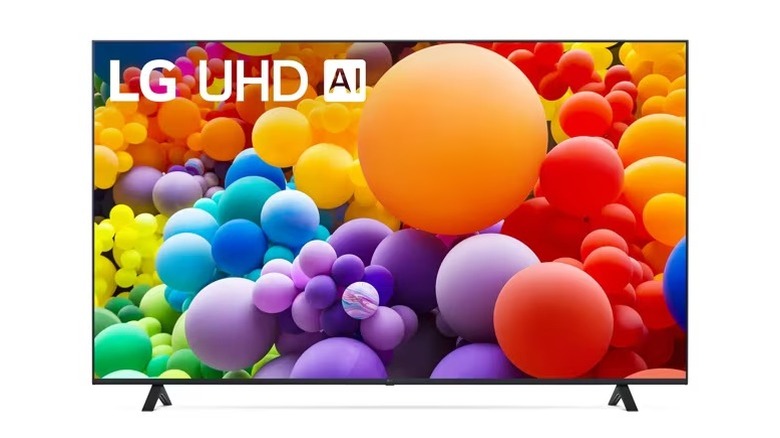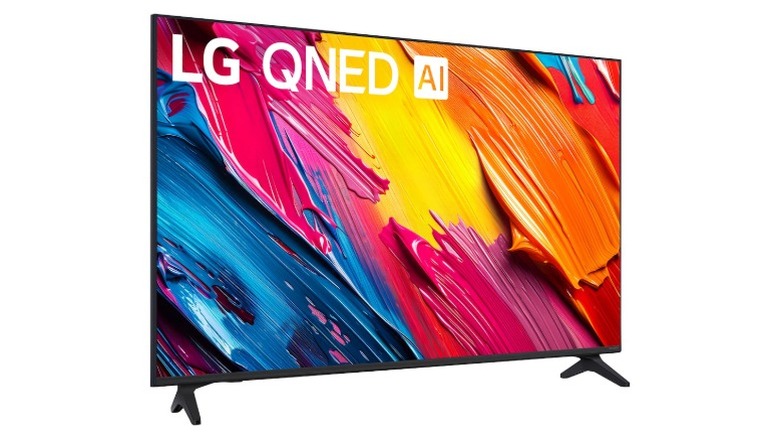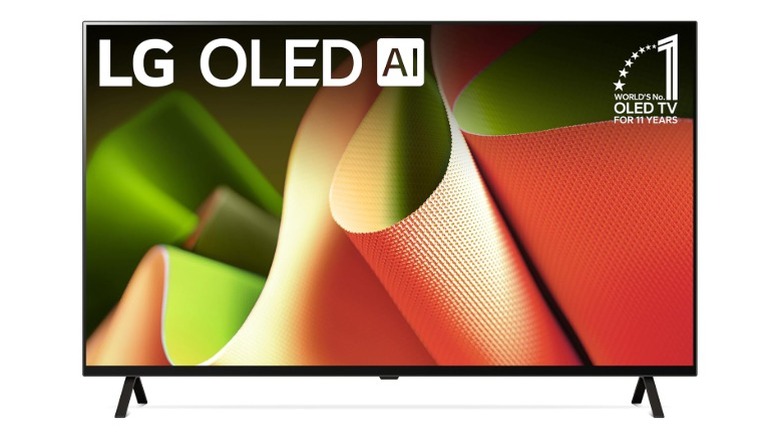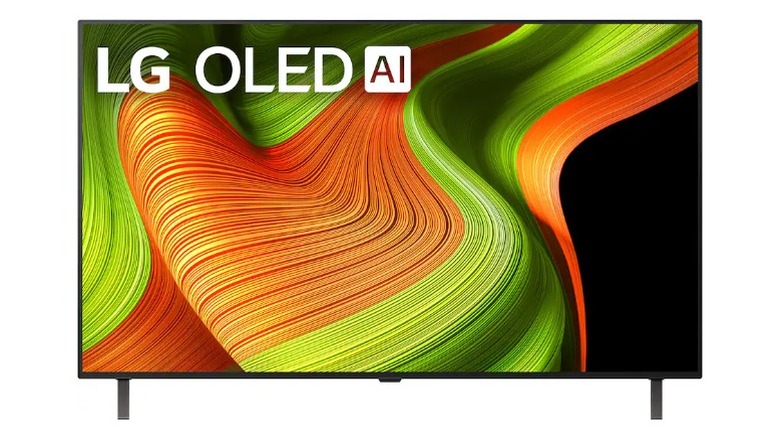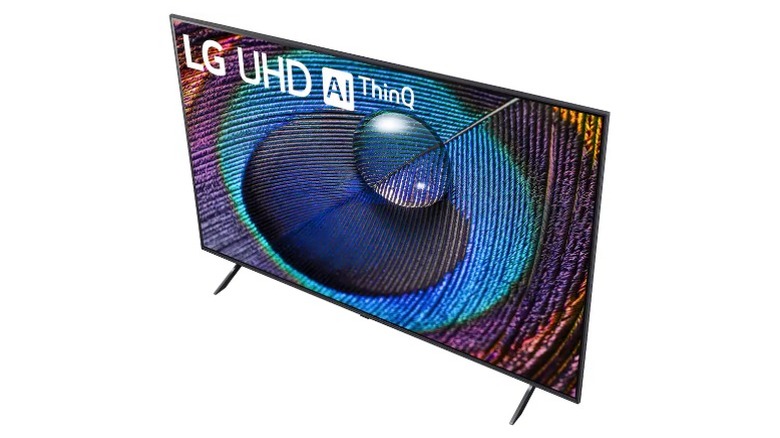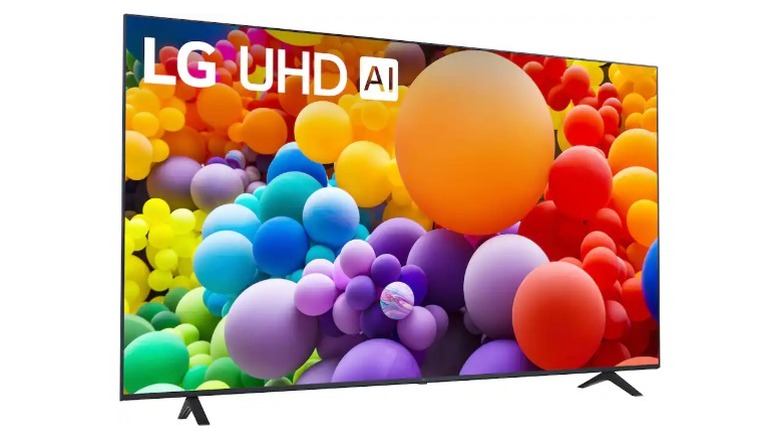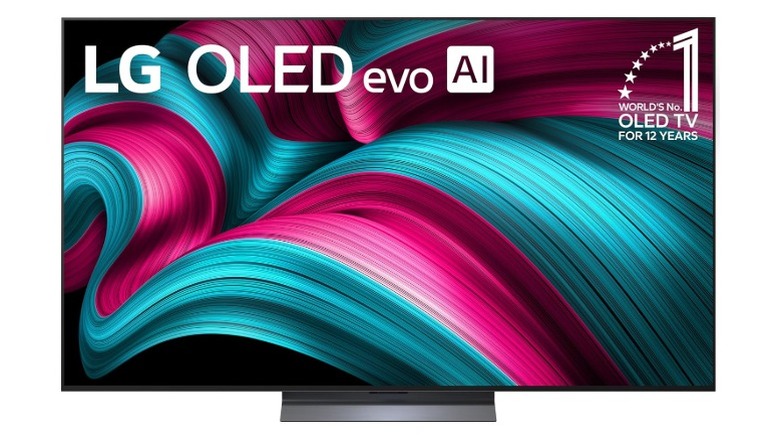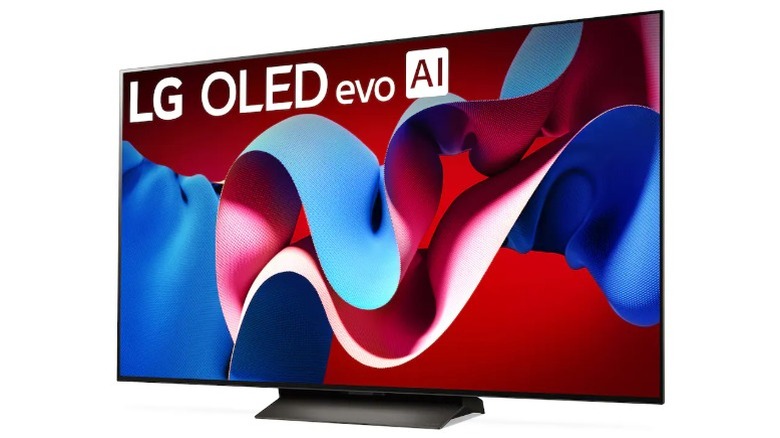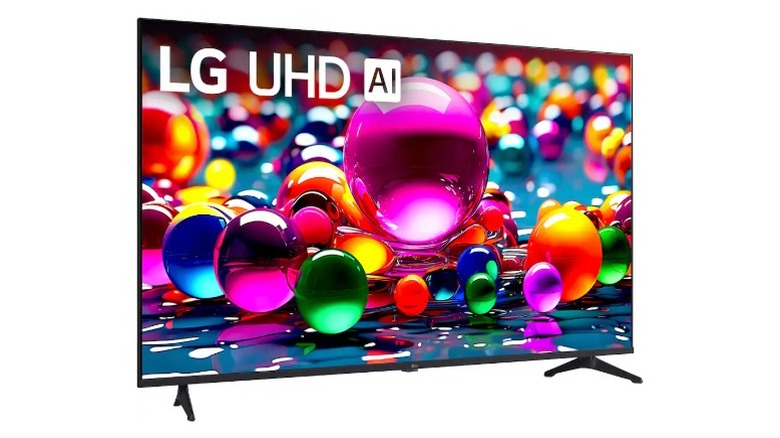The Best And Worst LG TVs, According To Consumer Reports
We may receive a commission on purchases made from links.
There's never been a better time than now to buy a flat-screen TV, at least when it comes to sheer choice. The best major TV brands offer a wide range of TVs to suit almost every potential customer, be they a home theater fanatic looking for the best of the best or a student who needs something just decent enough for game day. That said, we wouldn't disagree either if you said that some brands, such as LG, may actually offer too much choice.
The Korean giant has a wide range of TVs available in several product lines, so knowing which sets are worth your money and which ones are better avoided is essential if you're in the market for an LG TV. To that end, we've assembled a list of the best and worst LG TVs as of October 2025, based on the work of the fine folks at Consumer Reports (CR). These are mostly newer TVs released in the past few years, all of which are still available from online retailers at the time of writing.
Note that we've decided to discuss product lines in general, instead of honing in on specific TV models. While some product lines have one or two models that outperform the rest, we think this approach is the most practical overall, giving readers a general idea of where to look without getting too bogged down.
Best: LG G4
LG's 4K, 120Hz G4 OLED TVs were some of the best TVs money could buy in 2024, so it's probably not going to shock anyone that CR rates this lineup very highly. The 55-, 65-, and 77-inch G4 TVs sit near the top of CR's rankings for their respective sizes, and, if you've ever had the pleasure of seeing one in person, it's pretty obvious why: they have excellent OLED panels that combine the virtually infinite contrast of OLED with rich colors, great brightness (including in HDR) thanks to LG's Brightness Booster Max, and high-quality image processing and upscaling.
Speaking of HDR, the G4 TVs support Dolby Vision, HDR10 (but, sadly, not HDR10+), and HLG content, with filmmaker mode and LG's AI Picture mode also available to further tweak your viewing experience and potentially optimize your TV for movies. The G4 TVs aren't all about movies and TV shows, though; they're solid for gaming, too, with VRR support unlocking a slightly higher 144Hz maximum refresh rate. An automatic low-latency mode is available, as are LG's HGIG (HDR Gaming Interest Group) and Game Optimizer modes.
LG's G4 OLEDs have a 4.2 speaker system capable of Dolby Atmos, with support for LG Sound Sync if you're more of a soundbar person. They have a five-year panel warranty and, as of the time of writing, are on clearance at online retailers. Best Buy, for example, has the 77-inch LG OLED77G4WUA available for slightly under MSRP at the time of writing.
Best: LG G5
The G5 OLED TVs are LG's latest and greatest top-tier products, continuing the reputation the corporation established with previous G-series TVs like the G4 and G3. At the time of writing, CR has only ranked the 77-inch LG OLED77G5WUA and 55-inch OLED55G5WUA, and both are expectedly near the top, right alongside the older LG G4 TVs.
What does being on the cutting edge of LG OLED TVs get you, though? While the differences aren't necessarily night and day, they're still notable enough that a G5 may be worth considering if you have the budget. For one, the G5 TVs have LG's Brightness Booster Ultimate, compared to Brightness Booster Max on the G4. They also have a higher 165Hz refresh rate with VRR enabled. The G5 TVs also have newer image processing hardware in the form of LG's α11 AI Processor 4K Gen2, although it still lacks HDR10+ support.
The result is a range of TVs that's brighter and more vibrant than their predecessors, with an extra 21Hz of refresh rate for those seeking to pair their big-bucks OLED with an equally high-end living-room PC capable of hitting 165 FPS in modern titles. While the latter may only be of use to a small percentage of customers, the former should benefit everyone; Reviews indicate that the G5 OLEDs don't suffer from the washed-out colors that the G4s have when used in bright rooms, making them more versatile overall.
Worst: LG UT70
LG's UT70 TVs, which include the 75-inch LG 75UT7000PUA and the 43-inch LG 43UT7000PUA, are affordable 2024 TVs that CR isn't particularly keen on. They're far from the worst, but their unexceptional specs and hardware should offer no surprises as to why they're not highly rated.
These are direct-lit, 4K, 60Hz TVs with little in the way of notable features. There's no local dimming, for one, so the HDR10 and HLG support won't amount to much, and the 60Hz panel doesn't even support VRR to eliminate tearing when gaming. The α5 AI Processor 4K Gen7 is a few generations old by this point, too; For context, LG's top-tier 2024 TVs were running the α11 processor, making the UT70 TVs essentially old products given a new lick of paint and repackaged for budget-conscious buyers in 2024.
And that's really the whole point. Sure, CR doesn't rate these very highly, and they are generally a sub-par TV in the grand scheme of things (especially compared to LG's OLEDs), but they will still get the job done for those shopping on a tight budget. On the plus side, LG does at least offer the same five years of updates for its highly-regarded webOS as its pricier TVs, via its webOS Re:New program. One of these should remain up to date, software-wise at least, until 2029, provided the hardware doesn't fail.
Worst: LG QNED70A
LG's QNED TVs are a mixed bag. On the one hand, you have solid products like the LG 75QNED85TUA, which Consumer Reports considered one of the best 75-inch TVs under $1,000. On the other hand, there are the less-than-impressive products, like those from the QNED70A range.
Despite sharing a four-letter acronym, QNED has nothing to do with OLED, and doesn't offer the same image quality as the latter. Instead of self-emitting diodes (as with OLED), QNED TVs feature LG's Quantum Dot NanoCell layer for better color reproduction. Some also boast mini-LED backlighting, which provides full-array local dimming and an experience that, on paper, should be somewhere in between full-fat OLED and more traditional IPS panels. However, not every QNED TV manages this — and that, sadly, includes QNED70A TVs like the LG 55QNED70AUA.
The main downside is the lack of the aforementioned local dimming. Being budget-friendly models, the QNED70A TVs don't have the mini-LEDs of models like the QNED85. Instead, they're bog-standard direct-lit panels. Thus, while they support HDR10 and HLG content, you're likely not going to get a satisfactory HDR experience on LG's QNED70A TVs. The lack of mini-LEDs also makes them a poor choice on paper next to some of Hisense's best TV models, some of which offer mini-LED backlighting for not that much more money than their LG equivalents.
Best: LG B4
OLED technology is an excellent choice for TVs, with its great contrast and eye-catching colors setting OLEDs apart from all other panel types out there. But they can be pretty expensive, which is where LG's somewhat less-premium product ranges, like the entry-level B4, come into the picture. The Korean company's B4 TVs debuted in 2024 with three sizes to choose from: the 77-inch LG OLED77B4PUA, the 65-inch LG OLED65B4PUA, and the 55-inch LG OLED55B4PUA.
Consumer Reports loves the B4 TVs, which occupy the upper echelons of its rankings, behind the pricier G- and C-series OLED TVs. And while you are giving up some high-end features compared to those pricier models, the B4 still has all the crucial elements of a premium TV. These include a 120Hz refresh rate, VRR (LG specifically mentions FreeSync and Nvidia G-Sync compatibility), HDR compatibility (Dolby Vision, HDR10, and HLG), and its Dynamic Tone Mapping Pro feature.
One of the most noticeable cutbacks on paper will likely be the 2.0-channel built-in speakers, which lack the subwoofer channels of the higher-end LG OLEDs. But there are, of course, other limitations that you'll only notice in use, such as reduced brightness and increased glare when put side-by-side against LG's more expensive OLEDs. Stock of these B4 TVs may be a bit hard to come by now, given their age, but those of you seeking a budget option may benefit from clearance deals while they're still available.
Best: LG B5
Just like how day follows night, the 2024 LG B4 TVs were succeeded by the B5 TVs in early 2025. These TVs, available in anywhere from the living-room-friendly 48-inch dimensions of the LG OLED48B5PUA to the all-conquering 83-inch LG OLED83B5PUA, continue the B4 TVs' reputation as great-value OLEDs for more budget-conscious buyers.
Now, to be clear, the B5 TVs aren't revolutionary updates over their predecessors. They're still 120Hz, 4K, OLED TVs with the standard complement of HDR and gaming features you'd expect from a $1,000-plus product. So, yes, there's VRR, support for LG's usual trio of HDR formats (Dolby Vision, HDR10, and HLG), and four HDMI 2.1 connections for 4K 120Hz gaming, to name a few. There are some upgrades, although likely not significant enough to warrant an upgrade from those who already have a B4.
Changes include the addition of LG's α8 AI Processor 4K Gen2 image processor (the B4 has the first-gen version), support for Wi-Fi 6E instead of Wi-Fi 5, and LG's brand-new remote. Real-world performance is also similar, albeit subtly different: Comparisons note that the B4 is actually brighter than the B5 when displaying SDR content, with the tables turning in HDR. The newer TV is also less prone to glare, but conversely, is ever so slightly worse in bright rooms.
Worst: LG UR9000
The LG UR9000 TVs debuted in 2023 at the top of LG's array of budget TVs, offering a basic 60Hz 4K experience with lower-tier image processing and an interesting mix of positives and negatives that make it hard to recommend as a general-purpose display. The chief issue with the UR9000 TVs is the panel, which, unfortunately, offers the worst of both worlds: It's not bright enough to overcome glare, but poor contrast makes it a bad fit for dark rooms — a common issue with IPS panels. Low-quality local dimming is the icing on the cake, so to speak.
On the plus side, these UR9000 TVs may hold a bit more appeal to gamers. While they're limited to 60Hz and lack VRR support — making it a no-go for a living-room PC that can push beyond 60 FPS — you do get good input lag and built-in access to Nvidia GeForce Now cloud gaming. We wouldn't recommend buying a TV just for its cloud gaming support, mind you, but it's a nice extra if you're already using GeForce Now. Just make sure to tweak your device and network settings for the best GeForce Now performance if you're going down this route.
That said, there are several great gaming TVs for your consoles available in the same price range as LG's UR9000 TVs that offer higher refresh rates and VRR support. So, while it's not all bad, there's little that makes the UR9000 stand out if you're not limiting yourself to LG products.
Worst: LG UT75
Affordable TVs tend to perform poorly in CR's rankings, and so it goes with LG's UT75 family of TVs, an entry-level range of TVs launched in 2024 to replace the aging UQ75 TVs that debuted a couple of years earlier, in 2022. CR has the 43-, 55-, 65-, and 75-inch versions of the UT75 in its database, with all but the 75-inch unit among the worst-rated TVs for their sizes.
As you might expect from budget-oriented products, the UT75 TVs are thoroughly unexceptional spec-wise. These 4K TVs are direct-lit and run at a fixed 60Hz without VRR support. HDR10 and HLG support are present, but the lack of local dimming means that you're not going to get much joy out of HDR content. The speakers are also basic, with a 2.0 setup, although the TV does have LG's AI-powered up-mixing feature to generate simulated 5.1 sound.
The real kicker, though, isn't the specs; it's the real-world performance. Rtings tested the 65-inch LG 65UT7570PUB and had little good to say about it. Notably inconsistent black levels, poor contrast, washed-out colors, subpar brightness, and blurry motion due to slow pixel response were just some of the criticisms the outlet leveled at this particular LG TV.
Best: LG C5
LG's C-series OLEDs sit in between the top-tier G-series and entry-level (at least, by LG OLED standards) B-series TVs, although you probably wouldn't know that judging by CR's rankings. C5 TVs like the 77-inch LG OLED77C5PUA essentially equal their higher-end equivalents in CR's eyes, making them strong contenders for those who are willing to compromise slightly and accept not having the absolute best of the best in their living rooms.
Putting the G5 and C5 next to each other reveals that, in a sense, you do get what you pay for: Tom's Guide, for example, found that the G5 had an overall brighter and more vibrant image, which may be worth the extra outlay for some. However, the rest of the experience is broadly similar, especially for console gamers; The G5's 165Hz VRR refresh rate is indeed higher than the C5's 144Hz, but it's arguably meaningless when all home consoles max out at 4K 120Hz anyway.
Another notable difference is the stand. Or, rather, the lack thereof; The C5 has a stand in the box, but the G5 is designed to be wall-mounted. You can, of course, wall-mount the C5 just fine with third-party hardware, but LG has sensibly opted to keep things mainstream by including a stand — and a pretty good one, at that.
Best: LG C4
If you're ready to spend $1,000 or more on a TV, it makes sense to just go for the newest model possible — by which we mean LG's C5 TVs instead of the C4s. But these 2024 TVs are still entirely valid choices, with CR even rating some models higher than their newer C5 equivalents. There's not much in it, of course, and you'll be happy with either one, but it just goes to show that older doesn't necessarily equal worse when it comes to modern TVs — within reason, of course.
Like the C5, the C4 TVs come in sizes from 48 inches all the way up to 83 inches, all with 120Hz (or 144Hz with VRR enabled) 4K panels. The main difference is the processing hardware, with the C4's older α9 AI Processor 4K Gen7 lacking some new AI conveniences, such as a chatbot and automatic voice-based profile switching, available on the C5.
More practically, the C4 is slightly darker in SDR and HDR than its successor, although not by much. We expect the differences to only be truly visible in side-by-side comparisons, and you're not going to be missing out too much by going with the older models. That said, given seemingly low stock for the C4 and the C5's similar pricing, you might as well just go for a C5 unless you happen upon a great deal.
Worst: LG UA77
Judging by Consumer Reports, LG's UA77 TVs are likely the worst that the company offers as of October 2025. CR has eight of these TVs in its current database, and all are at or near the bottom of its rankings. And these don't have the excuse of being old TVs, either; These are all 2025 products.
Now, to be fair to LG, the UA77 TVs are all entry-level models with price tags to match. The 65-inch LG 65UA7700PUB, for example, has an MSRP of $479. For context, the Sony XR-65X90L, one of the best 65-inch TVs under $1,000, is still nearly $900 when on sale, and has an MSRP above the $1,000 mark. What has LG sacrificed to hit these low prices, then? Well, for one, you're not getting HDMI 2.1 or ATSC 3.0, nor is there any sort of local dimming for its ADS panel. There's no Dolby Vision support, its built-in speakers are 2.0-channel, and the refresh rate tops out at 60Hz. You get VRR, at least, but these are basic TVs through and through.
Let's talk about that panel technology, though. ADS is essentially a variation of IPS, both being LCD-based display technologies. The manufacturer, BOE, claims that it offers better response time than IPS, albeit at the cost of reduced contrast. Reviews illustrate the latter well, with Rtings criticizing the black uniformity and contrast of the UA77 TVs. That said, the outlet wasn't keen on the ADS panels' motion clarity, either, so the tech may not be living up to its supposed response time advantage.
